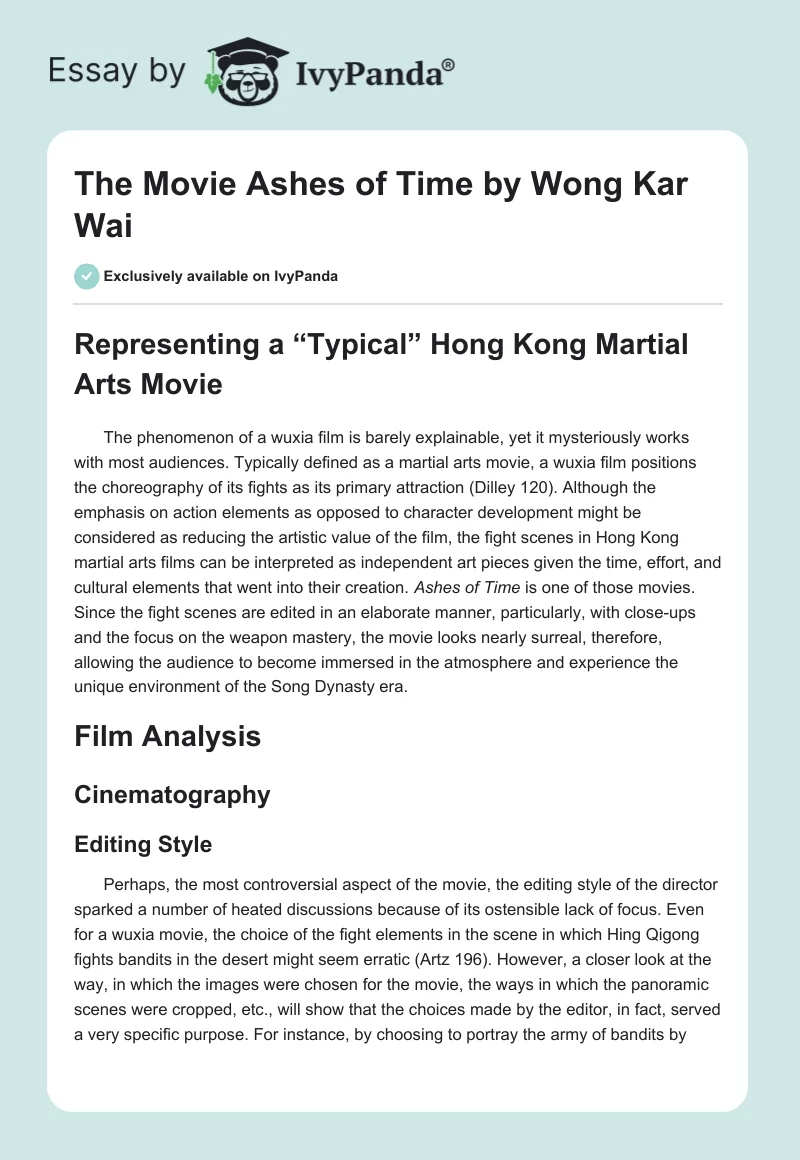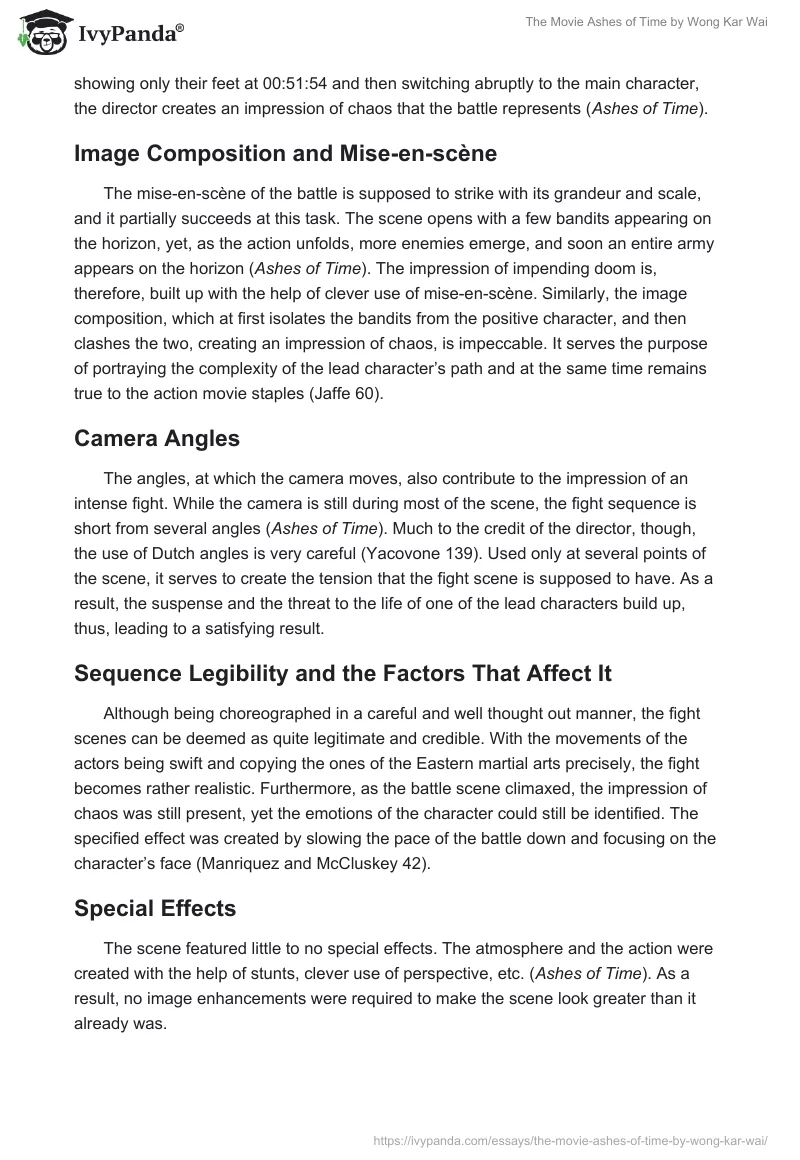Representing a “Typical” Hong Kong Martial Arts Movie
The phenomenon of a wuxia film is barely explainable, yet it mysteriously works with most audiences. Typically defined as a martial arts movie, a wuxia film positions the choreography of its fights as its primary attraction (Dilley 120). Although the emphasis on action elements as opposed to character development might be considered as reducing the artistic value of the film, the fight scenes in Hong Kong martial arts films can be interpreted as independent art pieces given the time, effort, and cultural elements that went into their creation.
Ashes of Time is one of those movies. Since the fight scenes are edited in an elaborate manner, particularly, with close-ups and the focus on the weapon mastery, the movie looks nearly surreal, therefore, allowing the audience to become immersed in the atmosphere and experience the unique environment of the Song Dynasty era.
Film Analysis
Cinematography
Editing Style
Perhaps, the most controversial aspect of the movie, the editing style of the director sparked a number of heated discussions because of its ostensible lack of focus. Even for a wuxia movie, the choice of the fight elements in the scene in which Hing Qigong fights bandits in the desert might seem erratic (Artz 196). However, a closer look at the way, in which the images were chosen for the movie, the ways in which the panoramic scenes were cropped, etc., will show that the choices made by the editor, in fact, served a very specific purpose. For instance, by choosing to portray the army of bandits by showing only their feet at 00:51:54 and then switching abruptly to the main character, the director creates an impression of chaos that the battle represents (Ashes of Time).
Image Composition and Mise-en-scène
The mise-en-scène of the battle is supposed to strike with its grandeur and scale, and it partially succeeds at this task. The scene opens with a few bandits appearing on the horizon, yet, as the action unfolds, more enemies emerge, and soon an entire army appears on the horizon (Ashes of Time). The impression of impending doom is, therefore, built up with the help of clever use of mise-en-scène. Similarly, the image composition, which at first isolates the bandits from the positive character, and then clashes the two, creating an impression of chaos, is impeccable. It serves the purpose of portraying the complexity of the lead character’s path and at the same time remains true to the action movie staples (Jaffe 60).
Camera Angles
The angles, at which the camera moves, also contribute to the impression of an intense fight. While the camera is still during most of the scene, the fight sequence is short from several angles (Ashes of Time). Much to the credit of the director, though, the use of Dutch angles is very careful (Yacovone 139). Used only at several points of the scene, it serves to create the tension that the fight scene is supposed to have. As a result, the suspense and the threat to the life of one of the lead characters build up, thus, leading to a satisfying result.
Sequence Legibility and the Factors That Affect It
Although being choreographed in a careful and well thought out manner, the fight scenes can be deemed as quite legitimate and credible. With the movements of the actors being swift and copying the ones of the Eastern martial arts precisely, the fight becomes rather realistic. Furthermore, as the battle scene climaxed, the impression of chaos was still present, yet the emotions of the character could still be identified. The specified effect was created by slowing the pace of the battle down and focusing on the character’s face (Manriquez and McCluskey 42).
Special Effects
The scene featured little to no special effects. The atmosphere and the action were created with the help of stunts, clever use of perspective, etc. (Ashes of Time). As a result, no image enhancements were required to make the scene look greater than it already was.
Editing
As stressed above, the process of editing was very long and complicated. One could argue that cutting some of the scenes did not make the movie look better and, instead, took away some of its credibility. However, by limiting the length of the action, the director managed to refine the battle scenes and make the action more intense (Brown 27).
Sounds
The sounds can be viewed as the weakest aspect of the movie. With the production quality set at the medium level, the opportunities to include a diverse range of sound effects were rather limited. Nevertheless, the impression of a battle scene was created rather successfully. The menacing sounds of drums and winds in the background as the suspense was beginning to build could be viewed as a staple of fight movies nowadays, yet it was rather creating at the time.
Following the Action
The director manipulated the length of some elements of the scene. As a result, it became comparatively easy to follow the action. While being fast-paced, it managed to remain focused.
Formal Elements and Emotional Impact
The formal elements of the movie related directly to its central theme, i.e., the quest that the hero had to complete. Although the identified character arch is admittedly simple, it has the charm that the unique environment and the original environment of a wuxia has. Focusing on not only the emotional journey of the protagonist but also on his development as a warrior, the movie set the standard for future martial arts films.
Works Cited
Artz, Lee. Global Entertainment Media: A Critical Introduction. John Wiley & Sons, 2015.
Ashes of Time. Directed by Wong Kar Wai, performed by Wong Kar-wai, Jeffrey Lau, and Jacky Pang, Jet Tone Productions, 1994.
Brown, Blain. Cinematography: Theory and Practice: Image Making for Cinematographers and Directors. CRC Press, 2016.
Dilley, Whitney C. The Cinema of Ang Lee: The Other Side of the Screen. Columbia University Press, 2015.
Jaffe, Ira. Slow Movies: Countering the Cinema of Action. Columbia University Press, 2014.
Manriquez, Antonio, and Tom McCluskey. Video Production 101: Delivering the Message. Peachpit Press, 2014.
Yacovone, Daniel. Film Worlds: A Philosophical Aesthetics of Cinema. Columbia University Press, 2014.


